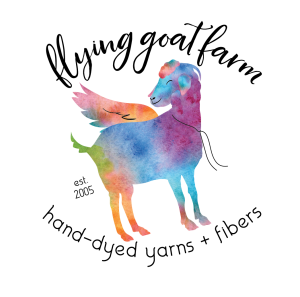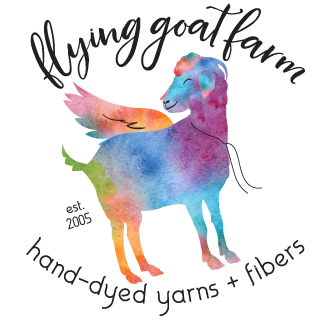I am asked all the time about making yarn from the fleeces of our animals. It all begins with the animals. A fiber farmer chooses what animals they will raise. Some are looking purely at fleeces, others research the general health or thriftiness of the breed itself. You can read about my choice of breeds: Blue Faced Leicester, Cormo and Angora Goats here.
Growth and maintenance of fleeces is a year round task. Many fiber farmers cover their sheep year-round to minimize the dirt and hay that can end up in fleeces. Some long wool breeds and angora goats don’t tolerate the covers as the fleeces felt under the covers. Covers themselves can be tricky when the animals are in between sizes, like my yearlings are right now. The covers are either too small and restrictive or too loose so they fall off. So we need to also look at how we feed hay so that the sheep and goats don’t pull hay on top of themselves.
Shearing can be done once or twice a year. It is important to shear carefully so that their aren’t second cuts. These are small usually less than 1/2 inch staple length pieces that result from the shearer making a second pass on the fleece. I am so lucky to have the services of an excellent professional shearer, Emily Chamelin. She shears quickly so the animals are not traumatized and with very few second cuts.
photo by Kelsey
After shearing, we need to skirt the fleece. This means that the nasty and really dirty bits are removed from the prime fleece. At this point, I make the decision about the fate of each fleece. Is it clean enough to be sold to a handspinner? Is the character of the fleece consistent throughout the fleece? If so that fleece can be set aside for our prime yarn. Or are there neck and leg parts that are not the same quality? If this is the case, I take off those pieces and collect them from all the fleeces to be made into a different kind of yarn or roving.
When I have a sufficient quantity of prime Cormo or Blue Faced Leicester, I can then make my design decisions about the yarn. What weight? Blended with what? What kind of ply? Which mill to use for which processes? Collaborate with another fiber farmer to increase the quantity?
I choose to use a mill because I have limited time available to do the rest of the processing myself. The mill will wash, pick, card, comb, spin, ply and skein the yarn for me. Each process adds a cost to the end product. Whether it is the machinery, the operator or both, I have found that each mill has adds character to the yarn as well. My understanding of what the mill adds is part of my yarn design process. One spins and plies more tightly, another has a looser ply resulting in a less structured yarn.
My newest custom farm yarn is Cirrus. It is a 3 ply Fingering weight blend of wool and alpaca all locally grown and custom mill spun. Each skein is 600 yards. The wool and alpaca are fine with a lot of crimp. The alpaca does not take the dye to the same saturation as wool, so there is a heathery or tweedy appearance. There is enough yarn in each skein to make a beautiful shawl that will be soft, warm and lightweight. To buy this yarn now, click on the photo and you will find it in our webstore.
So next time you look at a yarn from a fiber farm, you will understand all the individual tasks and decisions made by that shepherd: breed, feed, shearing, skirting, processing all goes into making that yarn that you will use to make a beautifully crafted item that will be cherished for years to come.






